If you have been on Twitter for some time, the term “ARMY” might sound familiar. Indeed, this group of fervent fans of boys’ band BTS is a powerhouse of online activism. However, this grouping was not the first of its kind! This is how my professor introduced us to the political interest group named “Nosamo”. After thinking a long while about the link between digital media and society, I remembered this anecdote shared during the course “Economic Development and Democratization of South Korea” regarding the importance of online interest groups in democratic electoral process. In order to expand upon this part of online participation history, let’s take a peek at the turn of the millennium and South Korea’s first internet president.

The year is 2000 and marks the year that the political interest group “Nosamo” (로사모) was founded. The name of the group is short for Nomuhyeoneul Saranghaneun Saramdeurui Moim 노무현을 사랑하는 사람들의 모임 or “People who love Roh Moo-hyun” and serves as a platform to support the late Roh Moo-hyun (1946-2009). According to the literature this grassroots political interest group played a key role in securing the progressive Roh’s win in his party primaries and his subsequent ascension to president during the 2002 presidential election (Shin 2005, 44). But who was this man garnering massive support from Korea’s “have-nots”?
An unlikely candidate…
Roh was born with many political disadvantages in South Korea’s political climate favoring the wealthy and well-connected. He came from a poor farming family with little connections and only a commercial high school degree, passing the bar examination thanks to his own efforts alone. Before becoming a politician, Roh was an attorney defending college students who were arrested and tried because they participated in demonstrations and underground activities against the authoritarian military regimes in the 1970s and the 1980s (Shin 2005, 28). His adversary in the primaries of his party (the MDP or “Millennium Democratic Party”) was Lee Hoi-chang 이회창 (b. 1935) and was – simply put – Roh’s complete opposite coming from an elite background full of powerful connections and advocating for conglomerate-favoring policies (Shin 2005, 28, 44). This background however, would prove to not be as favorable as previously thought.
…in a changing informational landscape…
At that moment, two notable developments happened. First, South Korea’s printed media scene was recovering from a blow in its credibility due to a national tax audit revealing tax evasion from several major newspapers as well as from their respective owners. These owners dictated the editorial line of the journal into a conservative-oriented reporting, reporting that was very influential in public opinion making. One of these newspapers, the Chosun Ilbo had previously criticized the progressive incumbent president Kim Dae-jung’s (김대중1924-2009) policies and its continued negative depiction of Roh Moo-hyun however led to a boycott of the newspaper by college students and young progressive groups, which in turn led to a loss in image and prestige of the printed medium and a disillusioned population of young voters (Shin 2005, 29).
The second major development was the improvement of the information technology as a core policy of Kim Dae-jung’s administration. This was indeed the time when broadband Internet access spread like a wildfire across the peninsula. In other words, more people than ever had access to the internet, including aforementioned part of the youth disillusioned with printed mass media due to scandals and distorted reporting. It is then no wonder that online information sources founded by former student activists emerged, such as the website Oh my news, which played a pivotal role in sparking young and disillusioned voter’s interest in politics, namely in the MDP’s newly instituted primary election system (Shin 2005 30-31).
…creates the perfect storm!
With the scene set, let’s succinctly dig into Nosamo’s role in Roh Moo-hyun’s win in the MDP’s primaries. Nosamo’s started as an idea after Roh’s defeat in the National Assembly election of April 2000. On May 17, the website was put online with the address www.nomuhyun.org, which was later changed to www.nosamo.org (Shin 2005, 34-35). Visitors on the website could register and become part of the organization. The constitution of the organization stipulated under article 2 that the members would participate voluntarily in the activity programs (Shin 2005, 35). Such activities included meetings, intracountry trips with Roh Moo-hyun as well as community service activities to promote regional unity. The amount of members rapidly increased, going from 500 members at the inaugural meeting on June 6 in 2000 to 4000 members one year later, the next figure cited being 70 000 members (Shin 2005, 35; Bhuiyan 2004, 123). Directly relating to the primaries’ process: the members of Nosamo aggressively promoted the participation of their members and of voters in the electoral process, leading to 1 600 000 applications to be on the people’s electoral college, an institution that had “only” 33 250 seats. Moreover, 300 Nosamo members attended each of the 16 sites of the primaries accompanied with their spouses and children, making a strong impression of their commitment to Roh to the electoral college (Shin 2005, 36). Another key point in the success of this group, was its use of the Internet to communicate. Indeed, this allowed them to exchange information quickly and be swift in the organization of follow-up actions (Shin 2005, 37).

After Roh secured his place in the primaries, Nosamo had to retreat from influencing the electoral process due to election laws that prohibited campaign activities by private entities for a presidential candidate. The organization nevertheless indirectly influenced the process by sparking the interest of young voters in Roh’s positions (Shin 2005, 38). These voters later turned out to massively vote for him, making Roh the first president elected thanks to the internet. As a side note, this result was the combination of a perfect storm: an underdog-type progressive political candidate and the rollout of the world’s largest broadband internet network in the world at the time (Bhuiyan 2004, 116–17) combined with a highly-educated and disillusioned young voter population in search of a new leader. In this case, the outcome turned to stabilize Korea’s democracy. This does however not mean that the internet as a tool for political engagement always leads to democratic solidification. One recent counter-example is the rise of fascist groupings in the United States, as the storming of the Capitol in January 2021 reminds us.
Sources
- Bhuiyan, Serajul I. 2004. ‘Use of Internet in Political Participation in South Korea’. Asia Pacific Media Educator, nr. 15: 115–29. https://doi.org/10.3316/informit.951348706467556.
- Jo, Gisuk 조기숙. 2022. ‘“특별 인연” 이재명 안뽑았다, 노무현 홍보수석이 이 결정한 이유’. 중앙일보. 21 maart 2022. https://www.joongang.co.kr/article/25056824.
- Jo, Yeongseok 조영석. 2018. ‘[엄지의 힘]④노사모부터 문팬까지…온라인 정치참여의 역사’. 이데일리. 25 mei 2018. https://www.edaily.co.kr/news/read?newsid=01226726619212528.
- Shin, Eui Hang. 2005. ‘Presidential Elections, Internet Politics, and Citizens’ Organizations in South Korea’. Development and Society 34 (1): 25–47.


Recent Comments